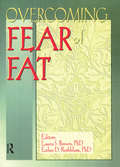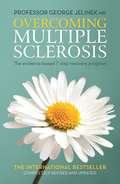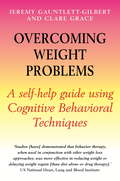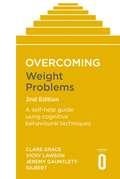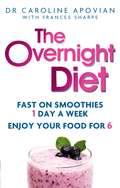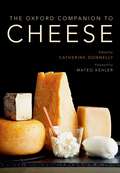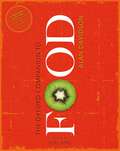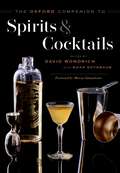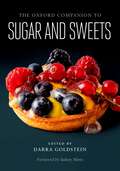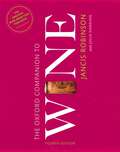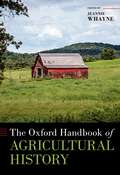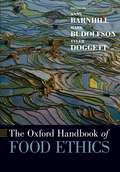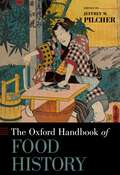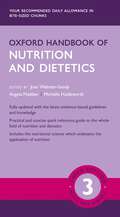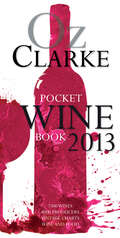- Table View
- List View
Overcoming Fear of Fat
by Esther D Rothblum Laura BrownHere is an enlightening new volume that presents an integration of anti-fat-oppressive attitudes into the work of feminist therapy. Overcoming Fear of Fat is unique among professional work in the area of women and fat in that it does not approach size as the problem; rather it approaches prejudice against fat as the problem. Although for nearly a decade, fat activists have been raising the issues that are confronted in this book, therapists, including feminist therapists, have been colluding with their clients in pathologizing fat, celebrating weight loss, and failing to adequately challenge cultural stereotypes of attractiveness for women, instead of empowering clients and encouraging them to take on expert authority about their own experiences. The contributors, including therapists and fat activists, aim to disconnect the issues of food intake and eating disorders from those of weight. They share personal and professional experiences of challenging fat oppression, offer strategies for therapists to rid themselves and their clients of fat oppressive attitudes, and most importantly, they confront long-held cultural myths that fat is unhealthy, and that fat women are physically unfit and are in hiding from their sexuality or personal power. A practical and informative resource for therapists, especially those who work with fat women or who themselves struggle with issues of feeling critical of their own body size, Overcoming Fear of Fat will also be a valuable guide for fat women who wish to feel supported in their struggle for self-worth and respect.
Overcoming Multiple Sclerosis: The Evidence-based 7 Step Recovery Program
by Professor George Jelinek MDOvercoming Multiple Sclerosis is an established and successful program of treatment. Once a diagnosis of MS meant inevitable decline and disability. Now thousands of people around the world are living healthy, active lives on the Overcoming Multiple Sclerosis recovery program.Overcoming Multiple Sclerosis explains the nature of MS and outlines an evidence-based 7 step program for recovery. Professor George Jelinek devised the program from an exhaustive analysis of medical research when he was first diagnosed with MS in 1999. It has been refined through major ongoing international clinical studies under Professor Jelinek's leadership, examining the lifestyles of several thousand people with MS world-wide and their health outcomes.Overcoming Multiple Sclerosis is invaluable for anyone recently diagnosed with MS, living with MS for years, or with a family member with MS. It makes an ideal resource for doctors treating people with MS.
Overcoming Weight Problems: A Self-help Guide Using Cognitive Behavioral Techniques (large Print 16pt) (Overcoming Books)
by Clare Grace Jeremy Gauntlett-GilbertFrom their ground-breaking work with CBT techniques in London's only NHS clinic for obesity, Drs Jeremy Gauntlett-Gilbert and Clare Grace have developed this accessible self-help guide, based on clinically tested methods that will help change thinking and overcome weight problems once and for all. How to:- - Develop real motivation to change - Deal with negative patterns of thinking and blocks and understand why you have gained weight and can't shift it - Develop a healthy and sustainable eating plan and understand why quick-fix diets are not the answer- Bring more activity into life over the long term - Handle difficult emotions and physical feelings
Overcoming Weight Problems 2nd Edition: A self-help guide using cognitive behavioural techniques (Overcoming Books)
by Clare Grace Vicky Lawson Jeremy Gauntlett-GilbertThis clinically tested, comprehensive course based on cognitive behavioural therapy (CBT) techniques can provide a longer-term solution to your weight problems. You'll come to understand your own psychological blocks to managing weight and discover how to sustain a healthy lifestyle. Learn how you can: - Develop the motivation to change your eating and activity- Respond to emotional eating in a helpful way- Work with the thoughts and emotions getting in the way of change- Work out a simple, healthy and sustainable eating plan that fits with your daily routine- Find easy ways to add more physical activity into your everyday lifeOvercoming self-help guides use clinically proven techniques to treat long-standing and disabling conditions, both psychological and physical. Many guides in the Overcoming series are recommended under the Reading Well scheme.Series editor: Emeritus Professor Peter Cooper
Overcoming Worries About Body Image and Eating: A Self-help Guide for Teenagers (Helping Your Child)
by Anne Stewart Caz Nahman Joanna AdamsMost teenagers worry about their body and appearance at some point, and some may try to alter their eating in order to change their weight or shape. If you are spending a lot of time worrying about how you look or what you are eating, it can become overwhelming and have a big impact on your life. The aim of this book is to help you to understand a bit more about these worries, what you can do about them and, most importantly, how you can develop a healthy relationship with your body and with food. If these worries take hold, there is a risk of developing an eating disorder or becoming depressed. Eating disorders can have a huge and negative impact on your physical health, your emotional wellbeing, your relationships and social life. They can take control of your mind and body, which makes it difficult to feel motivated to recover, and it can be a long and difficult journey to get back on track, so it's better to tackle these worries early on. Written by clinicians with many years of experience working in specialist eating disorder services for children and adolescents, this book follows an approach called cognitive behavioural therapy (CBT), which is a really useful way of helping us to make sense of our experiences and overcome the difficulties that we face. CBT is an evidence-based approach, which means that lots of research has been done to evaluate it and show that it can be helpful. The book includes help and support on: · Adolescent development, how we make sense of our experiences, healthy eating and how to look after yourself during the teenage years. · How you can stop body image and eating difficulties taking hold including ideas for feeling good about yourself, dealing with stress and managing social media. There is a chapter which focuses on issues for boys/young men. · How to get help from family, friends or professionals if you are struggling. There is also a chapter for parents/carers and families with suggestions on how they can help. Overcoming for Teenagers is a series to support young people through common mental health issues during adolescence, using scientific techniques that have been proven to work.Series editors: Associate Professor Polly Waite and Emeritus Professor Peter Cooper
The Overnight Diet: Start losing weight tonight and keep it off permanently
by Dr Caroline ApovianDiscover the no-fad weight-loss plan that successful dieters and top weight-loss experts are talking about . . .Premier weight-loss expert Dr Caroline Apovian has created the ultimate plan for anyone trying to lose weight. The Overnight Diet delivers exactly what dieters are desperately looking for: an easy-to-follow plan for rapid, lasting weight loss that doesn't compromise your health and energy levels. This cutting-edge diet accelerates fat-burning and primes the body to work at its best. Kick start your weight loss every week with a day of delicious smoothies called the '1-Day Power Up'. This produces powerful results when combined with the '6-Day Fuel Up', during which you can enjoy lean protein, low-fat dairy, whole grains and all-you-can-eat fruit and vegetables. Add in an easy-to-follow workout designed to rev up your metabolism and preserve lean muscle and you have the recipe for a slimmer 'you'. Many popular diets lead to 'shrinking muscle syndrome' - a loss of muscle mass that can rob you of energy, leave you weaker and flabbier and lead to yo-yo dieting. The Overnight Diet avoids all of these common problems. And the best news is that it's not a restrictive diet so there's no mealtime boredom. You can enjoy a wide variety of foods and even your favourite glass of wine. Look slimmer, feel better and live longer with The Overnight Diet.
The Oxford Companion to Cheese (Oxford Companions)
by Dr Catherine DonnellyWinner of the 2017 James Beard Award for Reference & Scholarship The discovery of cheese is a narrative at least 8,000 years old, dating back to the Neolithic era. Yet, after all of these thousands of years we are still finding new ways to combine the same four basic ingredients - milk, bacteria, salt, and enzymes - into new and exciting products with vastly different shapes, sizes, and colors, and equally complex and varied tastes, textures, and, yes, aromas. In fact, after a long period of industrialized, processed, and standardized cheese, cheesemakers, cheesemongers, affineurs, and most of all consumers are rediscovering the endless variety of cheeses across cultures. The Oxford Companion to Cheese is the first major reference work dedicated to cheese, containing 855 A-Z entries on cheese history, culture, science, and production. From cottage cheese to Camembert, from Gorgonzola to Gruyère, there are entries on all of the major cheese varieties globally, but also many cheeses that are not well known outside of their region of production. The concentrated whey cheeses popular in Norway, brunost, are covered here, as are the traditional Turkish and Iranian cheeses that are ripened in casings prepared from sheep's or goat's skin. There are entries on animal species whose milk is commonly (cow, goat, sheep) and not so commonly (think yak, camel, and reindeer) used in cheesemaking, as well as entries on a few highly important breeds within each species, such as the Nubian goat or the Holstein cow. Regional entries on places with a strong history of cheese production, biographies of influential cheesemakers, innovative and influential cheese shops, and historical entries on topics like manorial cheesemaking and cheese in children's literature round out the Companion's eclectic cultural coverage. The Companion also reflects a fascination with the microbiology and chemistry of cheese, featuring entries on bacteria, molds, yeasts, cultures, and coagulants used in cheesemaking and cheese maturing. The blooms, veins, sticky surfaces, gooey interiors, crystals, wrinkles, strings, and yes, for some, the odors of cheese are all due to microbial action and growth. And today we have unprecedented insight into the microbial complexity of cheese, thanks to advances in molecular biology, whole-genome sequencing technologies, and microbiome research. The Companion is equally interested in the applied elements of cheesemaking, with entries on production methodologies and the technology and equipment used in cheesemaking. An astonishing 325 authors contributed entries to the Companion, residing in 35 countries. These experts included cheesemakers, cheesemongers, dairy scientists, anthropologists, food historians, journalists, archaeologists, and on, from backgrounds as diverse as the topics they write about. Every entry is signed by the author, and includes both cross references to related topics and further reading suggestions. The endmatter includes a list of cheese-related museums and a thorough index. Two 16-page color inserts and well over a hundred black and white images help bring the entries to life. This landmark encyclopedia is the most wide-ranging, comprehensive, and reliable reference work on cheese available, suitable for both novices and industry insiders alike.
The Oxford Companion to Cheese (Oxford Companions)
by Dr Catherine DonnellyWinner of the 2017 James Beard Award for Reference & Scholarship The discovery of cheese is a narrative at least 8,000 years old, dating back to the Neolithic era. Yet, after all of these thousands of years we are still finding new ways to combine the same four basic ingredients - milk, bacteria, salt, and enzymes - into new and exciting products with vastly different shapes, sizes, and colors, and equally complex and varied tastes, textures, and, yes, aromas. In fact, after a long period of industrialized, processed, and standardized cheese, cheesemakers, cheesemongers, affineurs, and most of all consumers are rediscovering the endless variety of cheeses across cultures. The Oxford Companion to Cheese is the first major reference work dedicated to cheese, containing 855 A-Z entries on cheese history, culture, science, and production. From cottage cheese to Camembert, from Gorgonzola to Gruyère, there are entries on all of the major cheese varieties globally, but also many cheeses that are not well known outside of their region of production. The concentrated whey cheeses popular in Norway, brunost, are covered here, as are the traditional Turkish and Iranian cheeses that are ripened in casings prepared from sheep's or goat's skin. There are entries on animal species whose milk is commonly (cow, goat, sheep) and not so commonly (think yak, camel, and reindeer) used in cheesemaking, as well as entries on a few highly important breeds within each species, such as the Nubian goat or the Holstein cow. Regional entries on places with a strong history of cheese production, biographies of influential cheesemakers, innovative and influential cheese shops, and historical entries on topics like manorial cheesemaking and cheese in children's literature round out the Companion's eclectic cultural coverage. The Companion also reflects a fascination with the microbiology and chemistry of cheese, featuring entries on bacteria, molds, yeasts, cultures, and coagulants used in cheesemaking and cheese maturing. The blooms, veins, sticky surfaces, gooey interiors, crystals, wrinkles, strings, and yes, for some, the odors of cheese are all due to microbial action and growth. And today we have unprecedented insight into the microbial complexity of cheese, thanks to advances in molecular biology, whole-genome sequencing technologies, and microbiome research. The Companion is equally interested in the applied elements of cheesemaking, with entries on production methodologies and the technology and equipment used in cheesemaking. An astonishing 325 authors contributed entries to the Companion, residing in 35 countries. These experts included cheesemakers, cheesemongers, dairy scientists, anthropologists, food historians, journalists, archaeologists, and on, from backgrounds as diverse as the topics they write about. Every entry is signed by the author, and includes both cross references to related topics and further reading suggestions. The endmatter includes a list of cheese-related museums and a thorough index. Two 16-page color inserts and well over a hundred black and white images help bring the entries to life. This landmark encyclopedia is the most wide-ranging, comprehensive, and reliable reference work on cheese available, suitable for both novices and industry insiders alike.
The Oxford Companion to Food (Oxford Companions Ser.)
by Alan Davidson Tom Jainethe best food reference work ever to appear in the English language ... read it and be dazzled' Bee Wilson, New Statesman First published in 1999, the ground-breaking Oxford Companion to Food was an immediate success and won prizes and accolades around the world. Its blend of serious food history, culinary expertise, and entertaining serendipity, was and remains unique. Interest in food, cooking, and the culture surrounding food has grown enormously in the intervening period, as has the study of food and food history. University departments, international societies, and academic journals have sprung up dedicated to exploring the meaning of food in the daily lives of people around the world, alongside an ever-increasing number of articles, books, programmes, and websites in the general media devoted to the discussion of food, making the Oxford Companion to Food more relevant than ever. Already a food writing classic, this Companion combines an exhaustive catalogue of foods, be they biscuits named after battles, divas or revolutionaries; body parts (from nose to tail, toe to cerebellum); or breads from the steppes of Asia or the well-built ovens of the Mediterranean; with a richly allusive commentary on the culture of food, expressed in literature and cookery books, or as dishes peculiar to a country or community. While building on the Companion's existing strengths, Tom Jaine has taken the opportunity to update the text and alert readers to new perspectives in food studies. There is new coverage of attitudes to food consumption, production and perception, such as food and genetics, food and sociology, and obesity. New entries include terms such as convenience foods, drugs and food, Ethiopia, leftovers, medicine and food, pasta, and many more. There are also new entries on important personalities who are of special significance within the world of food, among them Clarence Birdseye, Henri Nestlé, and Louis Pasteur. In its new edition the Companion maintains its place as the foremost food reference resource for study and home use.
The Oxford Companion to Spirits and Cocktails
by Noah RothbaumAnthropologists and historians have confirmed the central role alcohol has played in nearly every society since the dawn of human civilization, but it is only recently that it has been the subject of serious scholarly inquiry. The Oxford Companion to Spirits and Cocktails is the first major reference work to cover the subject from a global perspective, and provides an authoritative, enlightening, and entertaining overview of this third branch of the alcohol family. It will stand alongside the bestselling Companions to Wine and Beer, presenting an in-depth exploration of the world of spirits and cocktails in a groundbreaking synthesis. The Companion covers drinks, processes, and techniques from around the world as well as those in the US and Europe. It provides clear explanations of the different ways that spirits are produced, including fermentation, distillation, and ageing, alongside a wealth of new detail on the emergence of cocktails and cocktail bars, including entries on key cocktails and influential mixologists and cocktail bars. With entries ranging from Manhattan and mixology to sloe gin and stills, the Companion combines coverage of the range of spirit-based drinks around the world with clear explanations of production processes, and the history and culture of their consumption. It is the ultimate guide to understanding what is in your glass. The Companion is lavishly illustrated throughout, and appendices include a timeline of spirits and distillation and a guide to mixing drinks.
The Oxford Companion to Spirits and Cocktails
by Noah RothbaumAnthropologists and historians have confirmed the central role alcohol has played in nearly every society since the dawn of human civilization, but it is only recently that it has been the subject of serious scholarly inquiry. The Oxford Companion to Spirits and Cocktails is the first major reference work to cover the subject from a global perspective, and provides an authoritative, enlightening, and entertaining overview of this third branch of the alcohol family. It will stand alongside the bestselling Companions to Wine and Beer, presenting an in-depth exploration of the world of spirits and cocktails in a groundbreaking synthesis. The Companion covers drinks, processes, and techniques from around the world as well as those in the US and Europe. It provides clear explanations of the different ways that spirits are produced, including fermentation, distillation, and ageing, alongside a wealth of new detail on the emergence of cocktails and cocktail bars, including entries on key cocktails and influential mixologists and cocktail bars. With entries ranging from Manhattan and mixology to sloe gin and stills, the Companion combines coverage of the range of spirit-based drinks around the world with clear explanations of production processes, and the history and culture of their consumption. It is the ultimate guide to understanding what is in your glass. The Companion is lavishly illustrated throughout, and appendices include a timeline of spirits and distillation and a guide to mixing drinks.
The Oxford Companion to Sugar and Sweets (Oxford Companions)
by Darra GoldsteinA sweet tooth is a powerful thing. Babies everywhere seem to smile when tasting sweetness for the first time, a trait inherited, perhaps, from our ancestors who foraged for sweet foods that were generally safer to eat than their bitter counterparts. But the "science of sweet" is only the beginning of a fascinating story, because it is not basic human need or simple biological impulse that prompts us to decorate elaborate wedding cakes, scoop ice cream into a cone, or drop sugar cubes into coffee. These are matters of culture and aesthetics, of history and society, and we might ask many other questions. Why do sweets feature so prominently in children's literature? When was sugar called a spice? And how did chocolate evolve from an ancient drink to a modern candy bar? The Oxford Companion to Sugar and Sweets explores these questions and more through the collective knowledge of 265 expert contributors, from food historians to chemists, restaurateurs to cookbook writers, neuroscientists to pastry chefs. The Companion takes readers around the globe and throughout time, affording glimpses deep into the brain as well as stratospheric flights into the world of sugar-crafted fantasies. More than just a compendium of pastries, candies, ices, preserves, and confections, this reference work reveals how the human proclivity for sweet has brought richness to our language, our art, and, of course, our gastronomy. In nearly 600 entries, beginning with "à la mode" and ending with the Italian trifle known as "zuppa inglese," the Companion traces sugar's journey from a rare luxury to a ubiquitous commodity. In between, readers will learn about numerous sweeteners (as well-known as agave nectar and as obscure as castoreum, or beaver extract), the evolution of the dessert course, the production of chocolate, and the neurological, psychological, and cultural responses to sweetness. The Companion also delves into the darker side of sugar, from its ties to colonialism and slavery to its addictive qualities. Celebrating sugar while acknowledging its complex history, The Oxford Companion to Sugar and Sweets is the definitive guide to one of humankind's greatest sources of pleasure. Like kids in a candy shop, fans of sugar (and aren't we all?) will enjoy perusing the wondrous variety to be found in this volume.
The Oxford Companion to Sugar and Sweets (Oxford Companions)
by Darra GoldsteinA sweet tooth is a powerful thing. Babies everywhere seem to smile when tasting sweetness for the first time, a trait inherited, perhaps, from our ancestors who foraged for sweet foods that were generally safer to eat than their bitter counterparts. But the "science of sweet" is only the beginning of a fascinating story, because it is not basic human need or simple biological impulse that prompts us to decorate elaborate wedding cakes, scoop ice cream into a cone, or drop sugar cubes into coffee. These are matters of culture and aesthetics, of history and society, and we might ask many other questions. Why do sweets feature so prominently in children's literature? When was sugar called a spice? And how did chocolate evolve from an ancient drink to a modern candy bar? The Oxford Companion to Sugar and Sweets explores these questions and more through the collective knowledge of 265 expert contributors, from food historians to chemists, restaurateurs to cookbook writers, neuroscientists to pastry chefs. The Companion takes readers around the globe and throughout time, affording glimpses deep into the brain as well as stratospheric flights into the world of sugar-crafted fantasies. More than just a compendium of pastries, candies, ices, preserves, and confections, this reference work reveals how the human proclivity for sweet has brought richness to our language, our art, and, of course, our gastronomy. In nearly 600 entries, beginning with "à la mode" and ending with the Italian trifle known as "zuppa inglese," the Companion traces sugar's journey from a rare luxury to a ubiquitous commodity. In between, readers will learn about numerous sweeteners (as well-known as agave nectar and as obscure as castoreum, or beaver extract), the evolution of the dessert course, the production of chocolate, and the neurological, psychological, and cultural responses to sweetness. The Companion also delves into the darker side of sugar, from its ties to colonialism and slavery to its addictive qualities. Celebrating sugar while acknowledging its complex history, The Oxford Companion to Sugar and Sweets is the definitive guide to one of humankind's greatest sources of pleasure. Like kids in a candy shop, fans of sugar (and aren't we all?) will enjoy perusing the wondrous variety to be found in this volume.
The Oxford Companion to Wine (Oxford Companions)
by Julia HardingPublished in 1994 to worldwide acclaim, the first edition of Jancis Robinson's seminal volume immediately attained legendary status, winning every major wine book award including the Glenfiddich and Julia Child/IACP awards, as well as writer and woman of the year accolades for its editor on both sides of the Atlantic. Combining meticulously-researched fact with refreshing opinion and wit, The Oxford Companion to Wine presents almost 4,000 entries on every wine-related topic imaginable, from regions and grape varieties to the owners, connoisseurs, growers, and tasters in wine through the ages; from viticulture and oenology to the history of wine, from its origins to the present day. More than 180 esteemed contributors (including 58 new to this edition) range from internationally renowned academics to some of the most famous wine writers and wine specialists in the world. Now exhaustively updated, this fourth edition incorporates the very latest international research to present 300 new entries on topics ranging from additives and wine apps to WSET and Zelen. Over 60 per cent of all entries have been revised; and useful lists and statistics are appended, including a unique list of the world's controlled appellations and their permitted grape varieties, as well as vineyard area, wine production and consumption by country. Illustrated with almost 30 updated maps of every important wine region in the world, many useful charts and diagrams, and 16 stunning colour photographs, this Companion is unlike any other wine book, offering an understanding of wine in all of its wider contexts—notably historical, cultural, and scientific—and serving as a truly companionable point of reference into which any wine-lover can dip and browse.
The Oxford Handbook of Agricultural History (Oxford Handbooks)
by Jeannie WhayneAgricultural history has enjoyed a rebirth in recent years, in part because the agricultural enterprise promotes economic and cultural connections in an era that has become ever more globally focused, but also because of agriculture's potential to lead to conflicts over precious resources. History is replete with stories of armies standing or falling as a result of their supply of agriculturally produced commodities. Civilizations have likewise succumbed because of famine or crop-related pestilence, highlighting the critical nature of agriculture to both regional and global society. The importance and fragility of agricultural systems will come into much greater focus because of climate change in the twenty-first century, something farmers the world over have begun to reckon with. As its implications are manifested in droughts and floods that hamper crop production, urban people will become ever more conscious of their own reliance upon agriculture. The contemporary critical evaluation of agriculture reflects a transition from a framework that celebrated the positive aspects of the evolution of agriculture to one that also explores its negative implications, such as the emergence of intensive and extractive agriculture that has worked to the detriment of indigenous peoples and disrupted traditional political economies. The Oxford Handbook of Agricultural History reflects this rebirth and examines the wide-reaching implications of agricultural issues, bringing together the many historiographical traditions within geographic regions across the world that intersect either directly or indirectly in terms of agricultural history. Contributors to this volume include historians from around the world and specialists in European, American, African, Middle East, Russian, and Asian history. Essays touch on the green revolution, the development of the Atlantic slave plantation, the agricultural impact of the American Civil War, the rise of scientific and corporate agriculture, and modern exploitation of agricultural labor. The Oxford Handbook of Agricultural History is an essential volume for those interested in the myriad ways that agricultural systems affect our world.
The Oxford Handbook of Agricultural History (Oxford Handbooks)
Agricultural history has enjoyed a rebirth in recent years, in part because the agricultural enterprise promotes economic and cultural connections in an era that has become ever more globally focused, but also because of agriculture's potential to lead to conflicts over precious resources. History is replete with stories of armies standing or falling as a result of their supply of agriculturally produced commodities. Civilizations have likewise succumbed because of famine or crop-related pestilence, highlighting the critical nature of agriculture to both regional and global society. The importance and fragility of agricultural systems will come into much greater focus because of climate change in the twenty-first century, something farmers the world over have begun to reckon with. As its implications are manifested in droughts and floods that hamper crop production, urban people will become ever more conscious of their own reliance upon agriculture. The contemporary critical evaluation of agriculture reflects a transition from a framework that celebrated the positive aspects of the evolution of agriculture to one that also explores its negative implications, such as the emergence of intensive and extractive agriculture that has worked to the detriment of indigenous peoples and disrupted traditional political economies. The Oxford Handbook of Agricultural History reflects this rebirth and examines the wide-reaching implications of agricultural issues, bringing together the many historiographical traditions within geographic regions across the world that intersect either directly or indirectly in terms of agricultural history. Contributors to this volume include historians from around the world and specialists in European, American, African, Middle East, Russian, and Asian history. Essays touch on the green revolution, the development of the Atlantic slave plantation, the agricultural impact of the American Civil War, the rise of scientific and corporate agriculture, and modern exploitation of agricultural labor. The Oxford Handbook of Agricultural History is an essential volume for those interested in the myriad ways that agricultural systems affect our world.
The Oxford Handbook of Food Ethics (Oxford Handbooks)
by Anne Barnhill, Mark Budolfson and Tyler DoggettAcademic food ethics incorporates work from philosophy but also anthropology, economics, the environmental sciences and other natural sciences, geography, law, and sociology. Scholars from these fields have been producing work for decades on the food system, and on ethical, social, and policy issues connected to the food system. Yet in the last several years, there has been a notable increase in philosophical work on these issues-work that draws on multiple literatures within practical ethics, normative ethics and political philosophy. This handbook provides a sample of that philosophical work across multiple areas of food ethics: conventional agriculture and alternatives to it; animals; consumption; food justice; food politics; food workers; and, food and identity.
The Oxford Handbook of Food Ethics (Oxford Handbooks)
Academic food ethics incorporates work from philosophy but also anthropology, economics, the environmental sciences and other natural sciences, geography, law, and sociology. Scholars from these fields have been producing work for decades on the food system, and on ethical, social, and policy issues connected to the food system. Yet in the last several years, there has been a notable increase in philosophical work on these issues-work that draws on multiple literatures within practical ethics, normative ethics and political philosophy. This handbook provides a sample of that philosophical work across multiple areas of food ethics: conventional agriculture and alternatives to it; animals; consumption; food justice; food politics; food workers; and, food and identity.
The Oxford Handbook of Food History (Oxford Handbooks)
Food matters, not only as a subject of study in its own right, but also as a medium for conveying critical messages about capitalism, the environment, and social inequality to diverse audiences. Recent scholarship on the subject draws from both a pathbreaking body of secondary literature and an inexhaustible wealth of primary sources--from ancient Chinese philosophical tracts to McDonald's menus--contributing new perspectives to the historical study of food, culture, and society, and challenging the limits of history itself. The Oxford Handbook of Food History places existing works in historiographical context, crossing disciplinary, chronological, and geographic boundaries while also suggesting new routes for future research. The twenty-seven essays in this book are organized into five sections: historiography, disciplinary approaches, production, circulation, and consumption of food. The first two sections examine the foundations of food history, not only in relation to key developments in the discipline of history itself--such as the French Annales school and the cultural turn--but also in anthropology, sociology, geography, pedagogy, and the emerging Critical Nutrition Studies. The following three sections sketch various trajectories of food as it travels from farm to table, factory to eatery, nature to society. Each section balances material, cultural, and intellectual concerns, whether juxtaposing questions of agriculture and the environment with the notion of cookbooks as historical documents; early human migrations with modern culinary tourism; or religious customs with social activism. In its vast, interdisciplinary scope, this handbook brings students and scholars an authoritative guide to a field with fresh insights into one of the most fundamental human concerns.
Oxford Handbook of Nutrition and Dietetics (Oxford Medical Handbooks)
by Joan Webster-Gandy, Angela Madden, Michelle HoldsworthThe importance of nutrition in the prevention and treatment of disease and the maintenance of good health is being increasingly recognised. Nutrition is an area that all health professionals need to be aware of and yet one in which few are specifically trained. However it is now becoming a valued topic in many curricula. The Oxford Handbook of Nutrition and Dietetics makes this information more accessible to dieticians, doctors, nurses, nutritionists, and other healthcare professionals by providing a practical, easily accessible, concise and up-to-date evidence-based guide in a user-friendly portable handbook. It covers the entire life cycle from preconception to old age. As the general public is increasingly aware of the food they eat and the role nutrition plays in health and disease, health professionalsmust have the kind of knowledge in this book at their fingertips.
Oxford Handbook of Nutrition and Dietetics (Oxford Medical Handbooks)
The importance of nutrition in the prevention and treatment of disease and the maintenance of good health is being increasingly recognised. Nutrition is an area that all health professionals need to be aware of and yet one in which few are specifically trained. However it is now becoming a valued topic in many curricula. The Oxford Handbook of Nutrition and Dietetics makes this information more accessible to dieticians, doctors, nurses, nutritionists, and other healthcare professionals by providing a practical, easily accessible, concise and up-to-date evidence-based guide in a user-friendly portable handbook. It covers the entire life cycle from preconception to old age. As the general public is increasingly aware of the food they eat and the role nutrition plays in health and disease, health professionalsmust have the kind of knowledge in this book at their fingertips.
Oxidative Stress and Inflammatory Mechanisms in Obesity, Diabetes, and the Metabolic Syndrome
by Helmut SiesCharacterized by obesity, insulin resistance, dyslipidemia, and hypertension, metabolic syndrome is associated with the risks of type 2 diabetes mellitus and cardiovascular disease. Obesity, which increases the incidence of atherosclerotic cardiovascular disease and subsequently leads to increased stress and inflammation, appears to play a central
Oz and James's Big Wine Adventure
by James May Oz ClarkeAn inspiring introduction to French wine with a unique travel angle, tied in to a primetime 6-part BBC2 series, Oz and James's Big Wine Adventure brings us French wine made simple. Oz Clarke - award-winning writer, critic and committed Francophile - is one of the world's leading authorities on French wine. James May - overgrown boy racer , Top Gear presenter and journalist - knows nothing about wine and loathes what he calls 'wine ponces'. In Sideways style, they travel through the regions of France for 6 weeks. Oz teaches James about wine with the aim of turning him into a top sommelier, while the pair eat together, get drunk together and sometimes have to sleep together for a few nights under canvas. Divided by region, Oz and James's Big Wine Adventure cuts through the fear and snobbery that surround French wine, providing an informative, entertaining and accessible guide to the French regions and their wines. Beautifully illustrated with over 80 landscape photographs and location shots, it is full of useful information on wine-making, wine culture, regions and tips on how to seek out the best the French vineyards have to offer.
Oz Clarke My Top Wines for 2013: Delicious, Good Value Wines To Try Tonight
by Oz ClarkeOz Clarke, Britain's favourite wine writer and broadcaster, is absolutely in tune with what wine drinkers want today – flavour, individuality, excellent value for money and wines that are readily available. Oz has tasted thousands of wines and selected his 250 Best Wines for 2013. Oz shows you how to find the flavours you want, from refreshing whites and fashionable rosés, through juicy, fruity gluggers to serious, spicy reds that are perfect partners for food. The guide includes sparkling wines, from Champagne to Prosecco and Cava and fizz from Australia, New Zealand and England, luscious pudding wines and ports and appetizing sherries. This new edition of Oz Clarke’s phenomenally successful annual Wine Buying Guide also contains: a guide to wine flavours; wine finder by country and by producer; storing, serving and tasting; buying for the long term; and a directory of the UK's top retailers, from fine wine merchants to supermarkets and high street chains. My Top Wines for 2013 is the must-have shopping guide to make wine buying hassle-free. Oz's independent, enthusiastic and reliable recommendations will help you find the wines you want at the prices you want to pay, from £3.49 to £31.
Oz Clarke Pocket Wine Book 2013: 7500 Wines, 4000 Producers, Vintage Charts, Wine And Food
by Oz ClarkeYou can’t hold all the wine information you need in your head, but with this handy guide you can be sure it is available whenever you want it. Indispensable as ever, Oz Clarke’s now classic Pocket Wine Book is meticulously updated each year. This is the 21st edition and the book has more information, more recommendations, more facts, passion and opinion than any other comparable guide to wine. Organised in an easy-to-use A–Z format, the entries cover wines, producers, grapes and wine regions from all over the world. For optimum browsing, the guide includes a handy country by country index as well as a full producer index to help you find over 4000 of the world’s top wine producers and their wines. Detailed vintage charts with information on which of the world's top wines are ready for drinking in 2013, can be found on the inside front and back covers. New for this year is an extra 8-page colour section to add extra sparkle to the 2013 edition.
